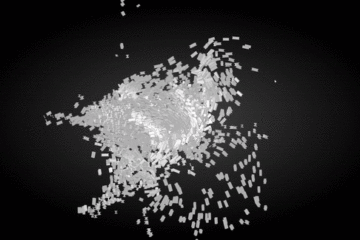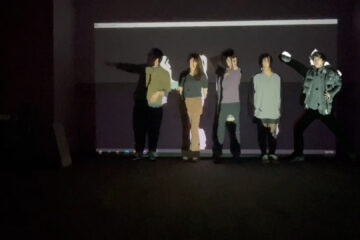Core Hours:
Monday 11AM – Noon, and 3PM – 7PM.
Tuesday 4PM – 7PM.
Wednesday 11AM – Noon, and 3PM – 7PM.
Thursday 4PM – 7PM.
Friday Noon – 4PM.
Weekly Meeting with Faculty:
Mo & Heather: Every Wednesday at 11AM.
Tech and Art Update:
- The programmers and artists have started using TouchDesigners for basic testing.
- The programmers have started playing with Azure Kinect and it is able to track for now with obvious lagging. Tracking one person is working. Tracking two persons led to a system crash. Will work on this later this week.
- The artists have finished the first round of mood boards and have brought to Mikael for critique.
- The artists have finished a really early stage of TouchDesigner visual generation.
Video Demo:
In this week’s demo, we tested the very basics of the software Touch Designer, the hardware Azure Kinect, and the basic tracking and projection mapping. We explore several different gestures such as standing, T-posing, moving around, overlapping (multiple persons), etc.
Mikael’s Update:
Here is a document that he emailed us with performance guidelines
Other than the previous deliverables, he wants to add a function to activate/deactivate the visual treatment when needed (for specific parts of the acts).
Updated visual reference notes:
| Uga Aka: The imagery of crystal onto performers’ body. Color Palette: Mono. Images that accentuate the blackness of outer space, the womb, the primeval ocean, etc. odu patterns coming out of hands and mouth and swirling on bodies; heighten moment | |
| Uga Chi: Mirrors and reflections are very important, Color Palette: Mono. Creating mirrored designs on each dancer’s body | |
| Uga Anwu: replace the key word “Chaos” with “Civilization.” Color palette: golden. Dancers as “children of the rising sun.” The light of human intellect. | |
| Uga Azi: Important themes are: chaos, pessimism, suffering, hyperspeed, things upside down, sensory overload. Color palette: not specified |
Team’s Questions and Concerns regarding the updated document.
Questions:
Here are some of the questions we had during our meeting that we would love to talk to Mikael about:
- For this entire project, we are working on Front Projection Mapping right? Mapping the performers horizontally only, as shown in the graph below. (And not mapping the performers from top to down, as if they are mostly lying and acting on the ground)
- How many projectors will there be? One for the background, and one for the projection mapping visual treatment for the performers? Or everything in one projector?
- When the visual treatment is deactivated, do you want us to still have the background, or do we shut off the background?
- For Act 1.5: “Dancers form 2 circles (inner circle and outer circle); they move in opposite directions looking up toward the light” Where is the light source for this one? Will this be like a stage light? Or a light looking thing in the background visual?
- Will we need to make any audio (sound, music) for the visual treatment?
- When we have more questions, we will ask Mikael again.
Concerns and Challenges:
Here are some of our challenges at this point based on the new guideline document that Mikael sent to us over the last weekend.
- Performers’ moving speed. We would imagine that this would be a problem throughout this project because there is a limit to what Azure Kinect is able to track, based on our tests at this moment. We are experiencing slow second to second frames performance (FPS), as well as lagging in terms of detecting body movement. For example, we are worried for Act 3.5 when: “Dancers do longer movement phrases and ‘fighting’ movement”. If this is too fast, the device might have problem following it.,
- Performers’ overlapping and abnormal behaviors. Again, due to the technical limitations, when the performers overlap, there might be problems recognizing when they are grouped together (heavily overlapping). Also, when the performers are performing abnormal, not up-standing gestures, the device might also not be able to recognize the person. For example, we are worried for Act 1.5 when: “They do a series of laying down and standing up to face the light (while still in the circle)” We assume here will be quite some overlapping and abnormal behaviors such as laying down.
- Materials/fabric of the clothing for the performers. Depending on what materials the performers will be wearing, the tracking effect/efficiency might be different. We are still testing various sorts of fabric and we will keep Mikael Updated.
- External Lighting. If there is a stage light, this may influence the effect of tracking and projection. For example, in Act 1.5: “Dancers form 2 circles (inner circle and outer circle); they move in opposite directions looking up toward the light”
- Projector(s) Problem. There is no one-projector that solves all scenarios. Different projectors are built for different types or rooms. A medium-size theater space is going to use a different type of projector compared to a smaller-size one. (Short throw vs long throw projector). The amount of brightness, the throw distance, the resolution, everything is quite site-specific. If the black box theater space (460 Melwood Avenue, Pittsburgh, PA 15213) is slightly bigger than ETC room 3306, the same projector may be applied. But if we are going to a bigger venue, we probably have to test the venue’s projector to see if it works. We will look more into this, and hopefully put together a guideline for how to select the best projectors.
- Performers distance against background wall. If the performer stands downstage right or left, the projection mapping onto their body will cast shadow onto the background. Such black silhouettes will be somewhat obvious onto the projection background. (If using two projectors, it might work because one projectors can be dedicated for projecting the background only. Only using one projector is very likely going to have the shadow if the performers stand far from the background)
- Azure Kinect Accuracy. We are still testing how accurate the motion detection is for Azure Kinect.


